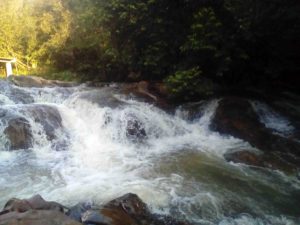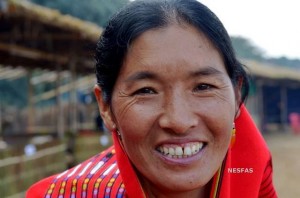
An environmental anthropologist and research fellow for the Indigenous Partnership, from Italy, Beatrice Del Monte set foot in Meghalaya in July 2015, to participate in and contribute to the Indigenous Terra Madre 2015. The conclusion of the ITM gave her a chance to initiate a study she had been formulating for the Indigenous Partnership for Agrobiodiversity and Food Sovereignty, in the previous months while working with NESFAS in Mooshakia (Jaintia Hills) on ‘Traditional and Contemporary ways to manage the local forests.’ The study which began later in November was conducted in close collaboration with the local community, NESFAS and Mr. HH Mohrmen, well-known environmentalist of Meghalaya.
Beatrice along with the participants of the study, made up of a group of 35 to 40 people including men, women and children, jointly decided that the sharing of the first results of the study should be marked with the celebration of the Terra Madre Day, locally known as Mei-Ramew Day with the Community of Moosakhia. It was planned that on this day, scheduled for the 18th of December, they would together discuss and validate the information they collected together which not only concerns land and forest but also food sovereignty that is for them almost always connected to the two topics.
Based on the findings of the study, the group discussed the importance of two major issues of Land and Forest.
- Land: As many communities in Meghalaya are facing the risk of landlessness, the village has started a process to register the land in the name of the main 3 Clans of the area, to whom the land traditionally belong (Paksang, Bareh and Kassar).
- Forest: The importance of an increase in the preservation of the forest present in the area with the involvement of the whole community was discussed. The community members agreed on the importance of starting a common dialogue to work together in this direction in order to avoid the complete disappearance of the forests.
The community felt strongly about the two issues as they believe that loss of sovereignty on land and forest would mean the loss of a majority of their source of food and their freedom to image their own futures, while preserving their traditions. The community of Mooshakia took a strong stand on the importance of building a common process based on dialogue and inclusion, which should involve the whole community.
The Study
The ancestors of the current inhabitants of Moosakhia lived in Umlané, a village located in a valley very close to the present village. When in 1930 an epidemic of Malaria affected the area, the population moved to a new area nearby, creating three new villages: Moosakhia, Samanong and Mupyut.
In Umlané the Bareh Clan was dominant. While moving in the three new settlements, the Bareh Clan split in to three – Bareh (Samanong), Paksang (Moosakhia) and Kassar (Mupyut). According to elders, the inhabitants of Umlané were informed about the impending tragedy by a sacred groove present in the area based on which they moved away from the area. This demonstrates the strong relation between this community and its forest.The land where the sacred groove is located and the land where the whole village use to cultivate broom belong traditionally to the three Clans. They have officially registered this land in 2010.
The land where the sacred groove is located and the plot where the whole village was cultivating broom earlier therefore traditionally belong to the three Clans hence, the land was officially registered to the community in 2010. Each of the Clans has a traditional representative who is in charge to control the preservation of the Sacred forest and the management the “Forest of broom”.
The Sacred Forest or ‘Law Kyntang’ is located not far from Umlané Village. It is completely forbidden to collect anything from this area and people are only allowed to cross it while animals are allowed to consume wild fruits or plants present there. According to tradition, the Lyngdoh of the Paksang family should perform sacrifices in the name of the three Clans once a year, in order to maintain the spiritual link with the forest. In recent years, the whole village slowly converted to Christianity. Only the family of the current Lyngdoh (Paksang), who reconverted 7 years ago to the traditional religion, resumed the traditional rituals and worked towards the preservation of the sacred forest.
A common practice to all the households of the village is the cultivation of broom, a cash-crop. Just 15 years ago it was cultivated as a shifting cultivation crop, with cycles of 10- 12 years (a traditional sustainable practice). Now the forest areas where broom was cultivated has almost completely disappeared and replaced with ‘BroomForests’. Even if it is referred to as Forest of Broom by the community members, it could be more properly indicated as ‘Land of Broom’.
Another type of land located on a community land is the restricted forest known as ‘Law Adong’. Wood for the households, firewood, and construction of new houses may be collected from here. It is however forbidden to take trees and wood from the forest for sale.
Those in charge of governing the two forests agree that an effort to increase the preservation/ protection of the sacred forest and of the Moosakhia landscape should be made. Some of the members were also inspired by a spiritual perception, as to the basis of preservation of the area, as they believe it is inhabited by supernatural Gods. The same individuals recognise the importance of preservation of the local landscape. A decision to extend the protection of the forest areas close to the sacred forest making it mandatory that broom cultivation is prohibited there, an act aimed towards the protection of the remaining wild animals there that are running out of a habitat.
Another factor governing the desire to protect the forests is the recognition of the value of the biodiversity present in the area (ex. Pithcer Plants) and the cultural and historical value assumed by it. The community also recognises that intensive mono-cropping has led to the loss of local agrobiodiversity in the recent past and connect it to the decline in the availability of wood used for household activities. This has reinforced the desire to increase and strengthen the area to be preserved.
This could be considered as an important starting point for the coming together of the community for its own wellbeing.



